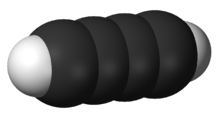Diacetylene
| | |
 | |
| Names | |
|---|---|
| Other names
1,3-butadiyne, buta-1,3-diyne, biacetylene, butadiyne | |
| Identifiers | |
| 460-12-8 | |
| ChEBI | CHEBI:37820 |
| ChemSpider | 9603 |
| |
| Jmol-3D images | Image |
| PubChem | 9997 |
| |
| Properties | |
| Molecular formula |
C4H2 |
| Molar mass | 50.06 g·mol−1 |
| Appearance | Gas |
| Melting point | −10 °C (14 °F; 263 K) |
| Boiling point | 10 °C (50 °F; 283 K) |
| Hazards | |
| MSDS | External MSDS |
| Main hazards | Highly flammable |
| R-phrases | R11 R19 |
| Except where noted otherwise, data is given for materials in their standard state (at 25 °C (77 °F), 100 kPa) | |
| | |
| Infobox references | |
Diacetylene (also known as butadiyne), with the formula C4H2, is a highly unsaturated hydrocarbon that contains three single bonds and two triple bonds. It is the first in the series of polyynes. The trivial name "diacetylene" refers to the two C-C triple bonds and the possible formation from acetylene (see below). It does not mean that diacetylene is the formal dimer of acetylene, what is rather true for Butenyne or Cyclobutadiene.
Occurrence
Diacetylene has been identified in the atmosphere of Titan and in the protoplanetary nebula CRL 618 by its characteristic vibrational modes. The molecule is most likely to have formed in Titan's atmosphere by a reaction between acetylene and the ethynyl radical C2H, which is produced when acetylene undergoes photolysis. This radical can in turn attack the triple bond in acetylene and react efficiently even at low temperatures. Diacetylene has also been found on the Moon.[1]
Preparation
This compound may be made by the dehydrohalogenation of 1,4-dichloro-2-butyne by potassium hydroxide at low temperature:[2]
- ClCH2C≡CCH2Cl → HC≡C-C≡CH
The bis(trimethylsilyl)-protected derivative may be prepared by the Hay coupling of (trimethylsilyl)acetylene:[3]
- 2 TMS-C≡CH → TMS-C≡C-C≡C-TMS
See also
References
- ↑ "The Multiplying Mystery of Moonwater", March 18, 2010. Retrieved on 2010-03-18.
- ↑ Verkruijsse, H. D.; Brandsma, L. (1991). "A Detailed procedure for the preparation of Butadiyne". Synthetic Communications 21 (5): 657. doi:10.1080/00397919108020833.
- ↑ Graham E. Jones, David A. Kendrick, and Andrew B. Holmes (1993). "1,4-Bis(trimethylsilyl)buta-1,3-diyne". Org. Synth.; Coll. Vol. 8, p. 63
Further reading
- Maretina, Irina A; Trofimov, Boris A (2000). "Diacetylene: a candidate for industrially important reactions". Russian Chemical Reviews 69 (7): 591. doi:10.1070/RC2000v069n07ABEH000564.
